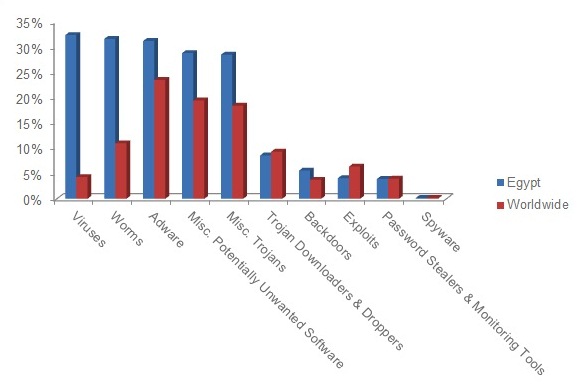
Reports by “Panda Security” claim that half of all computers worldwide are infected with malware. Although this data doesn’t seem accurate, infection rates worldwide are high and increasing annually. According to Microsoft Threat Assessment, Middle East is suffering from much higher rates of malware infection than other regions in the world.
Studying Microsoft Threat Assessment will give us more details on malware infections in the Middle East region. Types of infections will let us understand the vulnerabilities in the region and their linkage to cybercrime.
Algeria
Adware in Algeria seems to be the highest rate with 38.7% of all infected computers. Worms comes next with 36% of infection rate.
Bahrain
In Bahrain worms come first with 40.5% of all computers, and then come Trojans with 34.6% of infection rate.
Egypt
Viruses come first in Egypt with 32.3% of all computers then come worms with 31.6% of infection rate.
Iraq
Worms are common in Iraq with high infection rates at 36.4% of all computers, and then come Trojans with 29.9% of all computers.
Jordan
Worms is the highest infection rate in Jordan with 38.6% of all computers. Trojans is the second infection rate with 35.1% of all computers.
Kuwait
Trojans come first in Kuwait with 36.3% of all computers were infected. Worms come next with 28.9% of affected computers.
Lebanon
Worms is highest infection rate in Lebanon with 37.3% of all computers. Unwanted software which might include harmful adware, spyware, and dialers come next in Lebanon with 33.7% of all computers affected. 33.2% of all computers are also infected with Trojans.
Morocco
Worms is the highest infection rate in Morocco with 41.2% of all affected computers.
Oman
Worms come first in Oman with 42.7% of all computers infected with malware. Trojans found also with high infection rate at 34.7% of all computers affected.
Palestine
Trojans affected 40.9% of all computers in Palestinian Authority, and the come Worms with high infection rate at 36.6% of all computers.
Qatar
Worms come first at high infection rates in Qatar with 42.7% of all affected computers then Adware with 28.7%. Trojans are also found at high infection rates with 24.4% of all computers.
Saudi Arabia
Trojans affected 37.3% of all infected computers in Saudi Arabia, and then comes Potentially Unwanted Software (PUS) with 29.5% of all computers. Worms are also found at high rates with
Syria
Potentially Unwanted Software comes first with 37.6% of all infected computers. Trojans are found at high rate with 36.7% of all computers in addition to worms which affected 34.2% of all infected computers in Syria.
Tunisia
Adware in Tunisia infected 54.3% of all computers affected with malware. PUS comes next with 32.2% of all affected computers in addition to worms with infection rate at 27.6%.
UAE
Worms affected 36.2% of all computers infected with malware in UAE. Adware comes next with infection rate at 29.9% in addition to PUS at 27.3% of all infected computers.
Important facts:
Egypt is the most “Virus” infected nation in the Middle East. Higher rates of virus infections might be linked to high rate of “Pirated software” used by computer users in Egypt.
Most Middle East countries outpaced the rest of the world when it comes to infections of “Worms, Viruses, Trojans, and Adware”. The below chart shows infections in Egypt as an example:

Worms are also common infection in Middle East countries. Higher infection rates of worms can be used in DDoS attacks and Middle East ICT infrastructure can be used to conduct an organized cyber attack against other nations’ ICT infrastructure. Estonian case was one of the obvious examples which Egypt was involved in such attack!
Lack of cyber security capabilities and poor regulations are common factors in the region which make it vulnerable to cyber attacks. Trojan infection for example can be used to steal information from banks’ customers and Credit Cards data.
Potentially Unwanted Software, Adware, and Spyware infections might refer to poor security awareness among Middle East users. The fast growing numbers of Internet subscribers and mobile phone users will result in more infections and cybercrime cases to hit the region.
All malware infections are cyber crimes, but not all cyber crimes are caused by malware.
